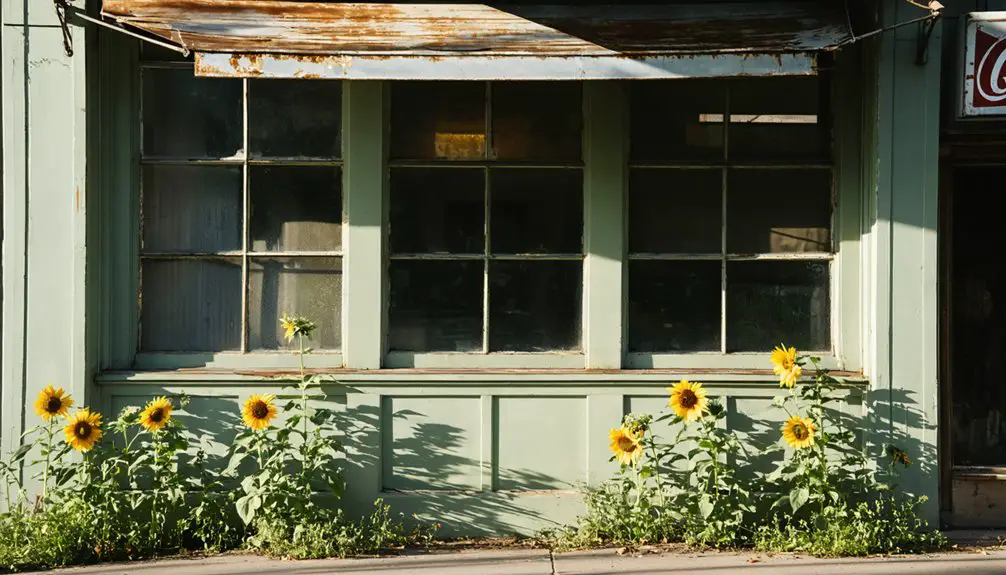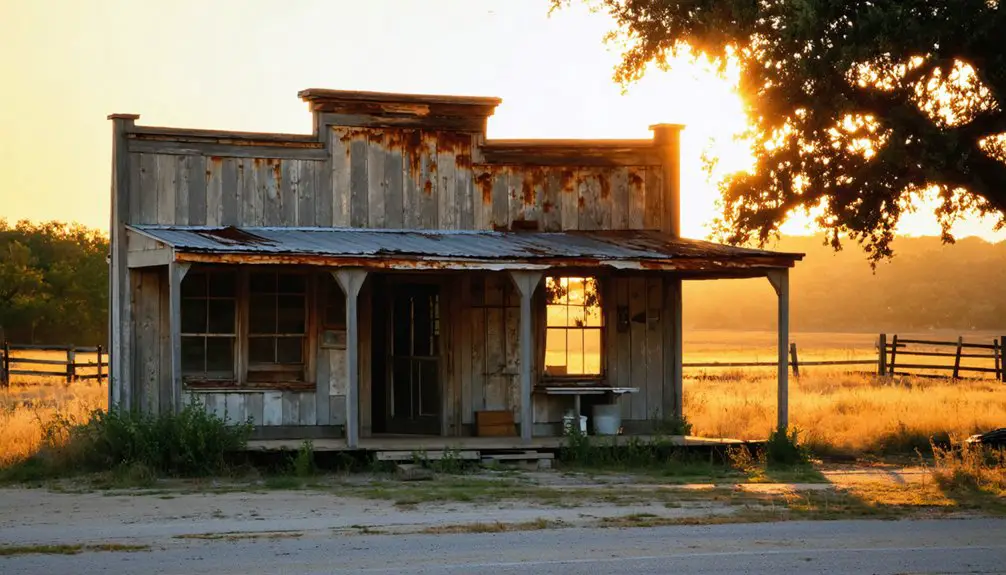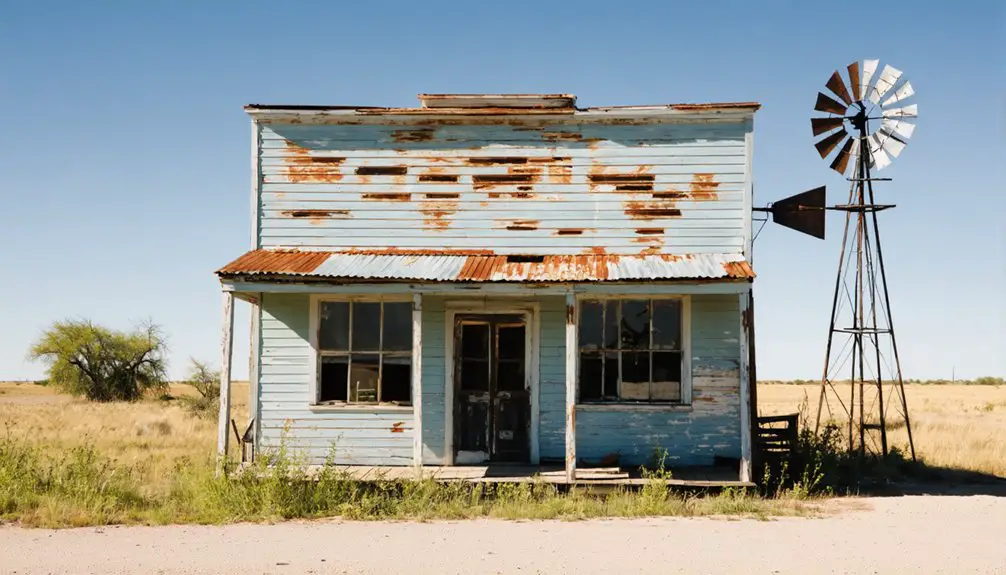You’ll find Bankersmith, Texas, established in 1913 along the San Antonio, Fredericksburg and Northern Railroad line. Named after banker Temple Doswell Smith, this strategic hub featured one of only two railroad tunnels in Texas and grew to 50 residents by the 1920s. While the town declined as rail transport faded, it’s now transformed into a Hill Country destination with a restored dance hall and saloon. The story of its remarkable revival holds more surprises.
Key Takeaways
- Bankersmith was established in 1913 as a railroad town with the construction of a unique 920-foot limestone tunnel through Texas Hill Country.
- The town reached its peak population of 50 residents in the 1920s before declining rapidly to just 10 residents by 1930.
- Historical features included a post office, store, and dance hall, centered around one of only two railroad tunnels in Texas.
- The ghost town experienced revival in 2012 with renovation of historic buildings into an event venue hosting up to 600 guests.
- Named after Temple Doswell Smith, a Fredericksburg bank president, the town’s original buildings showcase early 20th-century architecture.
The Birth of a Railroad Town
When the San Antonio, Fredericksburg and Northern Railroad arrived in 1913, it gave birth to the small town of Bankersmith, Texas.
You’ll find this piece of railroad history nestled in Texas Hill Country, where the town took its name from Temple Doswell Smith, a prominent Fredericksburg bank president with ties to local banking and railroad development.
The railroad’s arrival sparked town development around a strategic location south of Grapetown, where a station and sidetrack were built to handle both passenger and freight operations.
Though relatively small, the community maintained a steady presence as population never exceeded 50 residents during its peak years.
You can trace Bankersmith’s early growth directly to its role as a crucial transportation hub, complete with one of only two railroad tunnels in Texas.
The town’s layout evolved naturally around these railroad facilities, with the Old No 9 Highway providing additional access to this newfound community. The town quickly established itself with the opening of a post office in 1914.
Rise and Significance in Early Texas Transportation
You’ll find Bankersmith’s greatest significance emerged from its position as a significant railroad hub on the San Antonio, Fredericksburg and Northern Railway line, which connected the Hill Country towns of Fredericksburg and Comfort.
The town’s strategic location near the only railroad tunnel in Texas made it an indispensable stop for both freight and passenger service through the challenging terrain of the “Big Hill.” The construction required 250 laborers to complete the massive limestone tunnel.
In 1913, Rudolf Habenicht founded the town and carefully planned its development by laying out lots on both sides of the railroad tracks.
Railroad Hub Origins
The establishment of Bankersmith in 1913 marked a pivotal moment in Texas Hill Country’s railroad development, as the town emerged alongside the newly chartered San Antonio, Fredericksburg and Northern Railroad (SAF&N).
Under the guidance of chief construction engineer Foster Crane, this ambitious railroad construction project represented a grassroots triumph, with local residents raising funds to connect Fredericksburg to San Antonio. The station was named after Temple D. Smith, president of the Fredericksburg bank.
You’ll find Bankersmith’s strategic location halfway between Fredericksburg and Comfort wasn’t chosen by chance. The town’s positioning near the Gillespie County border made it an ideal stop along the SAF&N line.
This community development effort tackled challenging terrain, including the construction of a 920-foot tunnel, showcasing the determination of early Texas settlers to forge essential transportation links through the rugged Hill Country landscape. Like the Gulf Coast Lines expansion efforts of the early 1900s, this project demonstrated the era’s drive to establish vital rail connections throughout Texas.
Regional Transit Impact
Despite its modest size, Bankersmith played an essential role in early Texas transportation networks through its strategic position along both rail and road routes.
The town’s transportation legacy centered around the state’s only railroad tunnel, which conquered the imposing “Big Hill” limestone ridge in 1913, opening important access to Fredericksburg. The town was established by Rudolf Habenicht who recognized its potential as a vital transit point.
- You’ll find the town’s transit evolution marked by the key Old Route 9, connecting Fredericksburg to Comfort.
- You’re standing at a crossroads where the 1914 post office once integrated mail and passenger services.
- You’re witnessing the remnants of an engineering marvel that solved Hill Country’s accessibility challenges.
- You’re tracing the path where rail-to-automobile shift shaped Texas’s transportation future.
The town’s significance gradually diminished as automobiles replaced trains, leading to the rail line’s abandonment in 1935.
Life Along the Railroad Line
During Bankersmith’s peak in the 1920s, you’d find about fifty residents living alongside the bustling San Antonio, Fredericksburg and Northern Railroad, where daily passenger and freight service connected the small town to larger markets.
You’d see railroad workers and their families congregating at the local store, post office, and especially the dance hall, which served as the community’s social hub.
The town was named after Temple Doswell Smith, a prominent Fredericksburg banker who helped establish the railroad line.
The railroad’s disciplined operations gradually relaxed over time, as train crews would often pause their runs to hunt and fish, signaling the beginning of the line’s eventual decline.
The community’s original infrastructure was built on Rudolph Habenicht land, where both the post office and railroad depot were established.
Daily Rail Operations
Rigorous daily schedules defined life along the San Antonio, Fredericksburg and Northern Railroad, with trains departing Fredericksburg at 7:15 am for a two-hour journey to the junction connecting San Antonio-bound rails.
Passenger schedules and freight connections allowed you to travel or ship goods between major towns, with return trains departing San Antonio at 2 pm and arriving in Fredericksburg by 8 pm. The railroad managed to earn total revenue of $46,000 from combined passenger and freight operations in 1916.
- You’d witness trains traversing the challenging terrain, including Texas’s only railroad tunnel.
- You could board at various stops like Cain City, Bankersmith, and Mount Alamo.
- You’d experience the thrill of day trips between rural communities and San Antonio.
- You might catch crews stopping to hunt or fish during later years, as operational discipline waned.
As financial troubles mounted, the railroad entered receivership, marking the beginning of its decline through the 1910s.
Workers and Their Families
You’d find workers’ families living in mobile tent cities that followed construction progress, creating tight-knit communities along the tracks.
Despite their modest wages, families built a vibrant micro-economy in Bankersmith, complete with stores and dance halls.
The town’s peak population of 50 residents in the 1920s reflected the delicate balance between laborer struggles and family dynamics, though numbers dwindled to just 10 by 1930.
The Slow Fade Into Abandonment
Like many railroad towns of its era, Bankersmith’s decline began when the railroad’s importance diminished in the early 20th century.
The major decline factors included the gradual abandonment of rail services and lack of economic diversification beyond railroad support activities.
You’ll find that community erosion accelerated as residents moved to larger nearby towns like Fredericksburg and Comfort in search of new opportunities.
- The post office’s closure marked a turning point in the town’s viability
- Buildings and infrastructure fell into disrepair without maintenance
- Social institutions disappeared as families relocated
- The railroad tunnel, once a source of pride, became just another abandoned relic
The town’s position on the Kendall/Gillespie county line complicated matters further, as jurisdictional issues made it difficult to maintain services or attract new investment.
From Ghost Town to Hidden Gem

Despite its abandoned status, Bankersmith has transformed from a forgotten railroad stop into an engaging Hill Country destination.
You’ll discover hidden treasures throughout the property, from the historic railroad tunnel – the only one of its kind in Texas – to the beautifully preserved dance hall and saloon that now hosts events for over 500 guests.
The cultural revival of this 1913 railroad town showcases authentic early 20th-century architecture while offering modern amenities.
You’ll find a full-service bar and restaurant in the renovated saloon, complete with covered patio seating.
Positioned perfectly between Fredericksburg and Comfort, Bankersmith’s appeal extends beyond its ghost town charm.
The surrounding Hill Country scenery, proximity to Enchanted Rock, and connection to regional attractions like Wildseed Farms make it a distinctive venue for both history enthusiasts and event planners.
Modern Revival and Transformation
Bankersmith’s most dramatic transformation began in 2012 when ATX Brands owner Doug Guller purchased the property with ambitious plans.
The themed ownership initially rebranded it as “Bikinis, Texas,” but local opposition prompted a return to its historic name by 2015.
Through careful renovation and strategic planning, you’ll now find a versatile event destination that honors its Hill Country heritage.
- Dance your night away in Bankersmith Hall, hosting up to 600 guests
- Celebrate weddings and corporate events in authentic Texas style
- Enjoy multiple bars, including a unique vintage bus conversion
- Experience the charm of a genuine ghost town with modern amenities
The property’s evolution from controversial tourist spot to respected venue showcases how improved community relations and thoughtful development can breathe new life into historic locations while preserving their authentic character.
Preserving Texas Hill Country Heritage

As pressures from development threaten the Texas Hill Country‘s natural landscape, conservation efforts have become increasingly crucial to preserving the region’s rich heritage.
You’ll find only 5% of Hill Country lands under long-term protection, primarily concentrated in counties like Travis, Bexar, and Hays. The Texas Hill Country Conservation Network’s ambitious goals include protecting 100,000 additional acres and securing $400 million in conservation bonds.
Heritage preservation extends beyond land conservation. From 2016-2020, Texas added 193 properties to the National Register of Historic Places, highlighting the region’s cultural significance.
You’ll see how collaborative efforts between landowners, non-profits, and government bodies are essential in protecting both natural resources and historic sites. Local initiatives and preservation tools, including tax credits and economic incentives, help maintain the authentic character that makes Hill Country unique.
Frequently Asked Questions
What Paranormal Activity Has Been Reported in Bankersmith’s Abandoned Buildings?
You’ll encounter ghost sightings including a woman in white, an elderly male spirit, shadowy figures, and unexplained footsteps throughout the buildings, reflecting the town’s haunted history with cold spots and moving objects.
Are There Any Original Residents or Their Descendants Still Living Nearby?
While original families’ descendants likely live in nearby Fredericksburg and Comfort, you won’t find any confirmed residents in Bankersmith today. Local history suggests most families dispersed throughout the region after 1960.
How Much Did Doug Guller Pay for the Entire Ghost Town?
You’ll find that Doug Guller’s property acquisition of the ghost town cost him $1.5 million in 2012, when he discovered the listing on Craigslist and purchased the 1.56-acre property.
Can Visitors Explore the Old Railroad Tracks and Infrastructure Today?
Despite wanting to post a TikTok of the old tracks, you can’t freely explore them today – the railroad history is mostly on private land, with minimal preserved infrastructure beyond ruins.
What Is the Current Permanent Population of Bankersmith, Texas?
Based on current demographics, you’ll find no permanent residents in this former railroad town. Town history shows population declined from 50 in the 1920s to zero today, with only tourist facilities remaining.
References
- https://www.texasescapes.com/MichaelBarr/Traffic-Jam-in-Bankersmith.htm
- https://en.wikipedia.org/wiki/Bankersmith
- https://www.lifeofalley.com/what-to-do-in-the-historic-ghost-town-bankersmith-tx/
- https://www.texasescapes.com/TexasHillCountryTowns/Bankersmith-Texas.htm
- https://hillcountrysun.com/f/discover-bankersmith-texas
- https://texashillcountry.com/texas-hill-country-ghost-towns/
- https://kids.kiddle.co/Bankersmith
- https://www.tshaonline.org/handbook/entries/bankersmith-tx
- https://texashighways.com/culture/history/the-hill-country-legacy-of-old-tunnel-state-park/
- https://www.texashighwayman.com/pre-fwy-history.shtml



